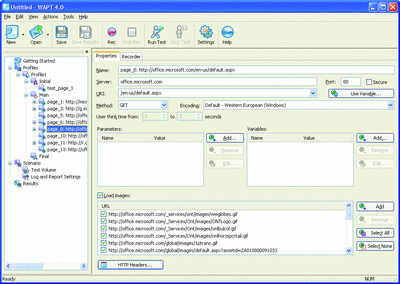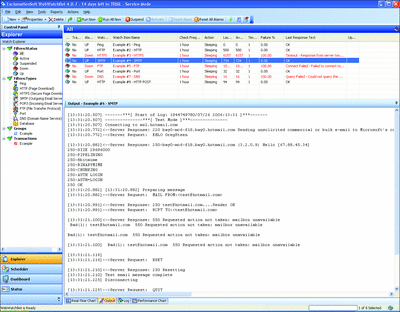ToolboxNew Products for IT Pros
Greg Steen
Stress Test Your Web Apps
WAPT Web Application Stress Tool
Knowing how the latest release of your Web application will perform is crucial to right-sizing your infrastructure and avoiding those high-pressure moments when the CEO asks you why she is getting a "Server Too Busy" response when checking out the site. And if you are on the hunt for a relatively low-cost, easy-to-use Web application stress and performance testing tool, you might want to check out WAPT 4.0 from SoftLogica LLC.
The application runs on most versions of Windows®, but you will want to use Windows 2000, Windows XP, or Windows Server® 2003 to gain the full potential because of the socket limitations on earlier versions. As with most performance testing applications that employ virtual users, the more memory, faster processor, and fatter network connection you have, the more virtual users you will be able to simulate with WAPT.
The documentation states a limit of around 2,000 virtual users for a PIV 2.4 with 512MB of RAM and a gig-e interface, but that is dependent on the type of application you are testing and how you set up your test profile. Another factor that will vary your testing is the delay between requests, which WAPT lets you set as user think time in a virtual user's profile.
Once you have finished setting up a virtual user profile (you can have many per-testing scenarios), you can create the test plan for that profile. WAPT divides the test sequence into three sections: Initial, Main, and Final Actions. These are more logical separations than functional, but they do suggest splitting your login or registration function, as an example, into the initial section and log out action in the final section. WAPT allows you to either enter the requests manually or use the integrated browser recorder to track how you would like users of this profile to surf through your site. Next, you can move onto the general settings to determine what the load should be for this test and whether you would like it to be fixed or ramp up to volume over a specified time period. During the test, WAPT can give you a real-time view of performance statistics for your test scenario. And after you have finished, you can save the results as HTML or CSV for future review.
Price: $350 per machine.
Knowing how the latest release of your Web application will perform is crucial to right-sizing your infrastructure and avoiding those high-pressure moments when the CEO asks you why she is getting a "Server Too Busy" response when checking out the site. And if you are on the hunt for a relatively low-cost, easy-to-use Web application stress and performance testing tool, you might want to check out WAPT 4.0 from SoftLogica LLC.
The application runs on most versions of Windows®, but you will want to use Windows 2000, Windows XP, or Windows Server® 2003 to gain the full potential because of the socket limitations on earlier versions. As with most performance testing applications that employ virtual users, the more memory, faster processor, and fatter network connection you have, the more virtual users you will be able to simulate with WAPT.

WAPT Web Application Stress Tool (Click the image for a larger view)
The documentation states a limit of around 2,000 virtual users for a PIV 2.4 with 512MB of RAM and a gig-e interface, but that is dependent on the type of application you are testing and how you set up your test profile. Another factor that will vary your testing is the delay between requests, which WAPT lets you set as user think time in a virtual user's profile.
Once you have finished setting up a virtual user profile (you can have many per-testing scenarios), you can create the test plan for that profile. WAPT divides the test sequence into three sections: Initial, Main, and Final Actions. These are more logical separations than functional, but they do suggest splitting your login or registration function, as an example, into the initial section and log out action in the final section. WAPT allows you to either enter the requests manually or use the integrated browser recorder to track how you would like users of this profile to surf through your site. Next, you can move onto the general settings to determine what the load should be for this test and whether you would like it to be fixed or ramp up to volume over a specified time period. During the test, WAPT can give you a real-time view of performance statistics for your test scenario. And after you have finished, you can save the results as HTML or CSV for future review.
Price: $350 per machine.
Book Review
Content Networking Fundamentals
Content is king and Content Networking Fundamentals (Cisco Press, 2006) by Silvano Da Ros helps you get on the fast-track of enhancing your content-delivery infrastructure. The book labels itself as "a comprehensive introduction to the theory and practical applications of content networking" and that is truly what it is. Though obviously biased towards Cisco's networking gear, the book provides a good sense of the different components of content networking along with practical guidelines for implementing the principles behind content networking that are applicable regardless of the types of content networking products in your infrastructure.
The book begins with a high-level overview of the different elements of content networking (which is really enhancing the performance and delivery of layer 4 through 7 communication of the OSI model). Then it delves into the nuts and bolts of major content presentation formats such as XML, HTML, WAP, and content transformation through XSLT at the network edge along with a section on delivery of streaming media. Finally, it gets into scalability and availability with discussions on server load balancing (both global and local), firewall load balancing, and use of content caching devices such as Cisco's content services switch.
If you use Cisco's content services switches in your infrastructure, you will find the chapter on switching secured content interesting. It will show you the details of configuring the content services module for secure sockets layer along with configuring URL and header rewriting. Generally, networking pros of any brand-loyalty will find the chapter on QoS useful for understanding different queuing mechanisms and congestion management.
In summary, though definitely heavy on the Cisco hardware implementations (after all, it is published by Cisco Press), this book will help you turn the buzz words of "content networking" into practical and applicable methodologies for your content delivery infrastructure.
Price: $55.00.
Monitor Your Services
WebWatchBot
www.exclamationsoft.com/webwatchbot/default.asp
One thing that can make or break an IT professional is his ability to detect (and hopefully fix) issues before end users in the organization detect them. Therefore, one of the most important tools an IT pro can have is an effective monitoring system that can delve into the different services you provide in order to verify that they are running as they should. ExclamationSoft's WebWatchBot can help you get there.
This application can monitor every common service you can think of. Instead of just verifying that a service is running, WebWatchBot takes the process one step further. It actually tests services to make sure they are functioning properly. For example, FTP verification can actually upload and download a file, DNS monitoring can execute any of 40 different query commands and search for a string in the response, and POP3 and SMTP tests actually log in and report on mail performance.

WebWatchBot (Click the image for a larger view)
In addition, WebWatchBot lets you chain a sequence of steps in a transaction and will report any errors or unacceptable latency (according to the thresholds you set) for the transaction as whole. The application also will monitor HTTP and HTTPS URLs and can check for specified content. You can even set up database monitors that will execute queries and check the data against a templated response.
Price: $495.95 per single-user license.
Greg Steen is a technology professional, entrepreneur, and enthusiast. He is always on the hunt for new tools and methods to help make operations and development easier for IT professionals.
© 2008 Microsoft Corporation and CMP Media, LLC. All rights reserved; reproduction in part or in whole without permission is prohibited.